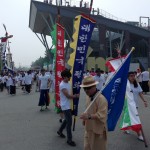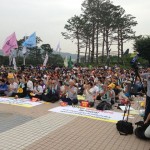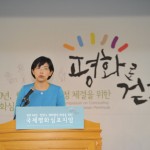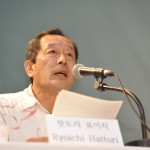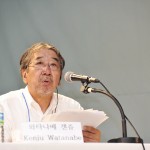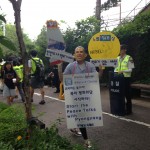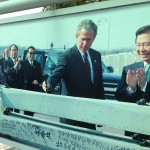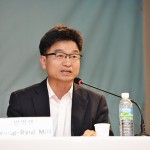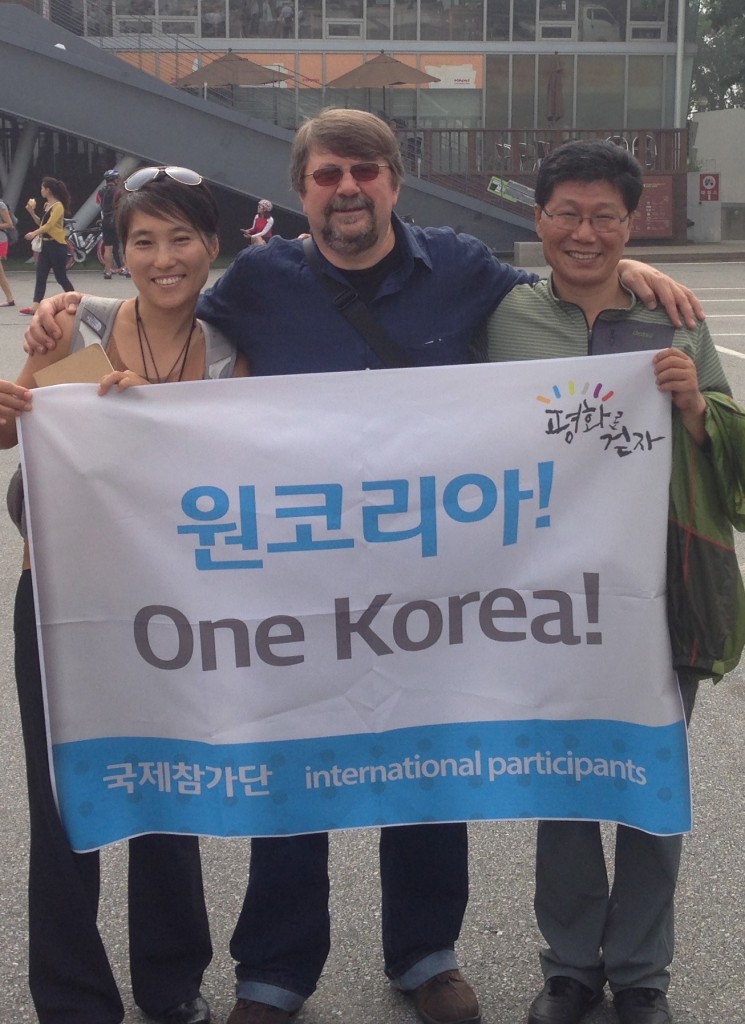I was in Seoul during the July 27 commemorations of the 60thanniversary of the armistice agreement that brought an end to the fighting in the Korean War, one of the most brutal conflicts of the 20thcentury. My visit was hosted by the Unified Progressive Party, a coalition of peace, labor and civil liberties activists that holds six seats in South Korea’s National Assembly.
That evening, about 25,000 people – including a few Americans – attended a very moving and colorful rally at the main Seoul Plaza to protest South Korea’s intelligence agency’s intervention in domestic politics, a major issue in South Korea today (sound familiar?). One of the speakers was a housewife who created a website on politics critical of the South Korean government. She has sued the KCIA (which has been renamed the National Intelligence Agency) for its sleazy tactic of using social media to viciously undermine opposition voices.
At one point, she received postings with pictures of her 10 year-old daughter threatening her with rape and worse. These abusive tactics have become a powerful issue, and the people are fighting back.
The other highlight was a tour, led by our Korean hosts, of two important symbols of South Korea’s path from a Japanese colony to a democratic nation – albeit with lingering signs of authoritarianism.
They were the Seodaemun Prison, where the Japanese colonial authorities held Korean independence fighters and South Korea’s postwar military governments imprisoned democratic activists; and the War & Women’s Human Rights Museum, a tribute to the sex slaves (known in Asia as “comfort women”) kidnapped and imprisoned by the Japanese Army during World War II. Many of the exhibits and photos at the prison were difficult to see, particularly those showing the Japanese use of water torture – a practice that the U.S. government and the CIA shamefully adopted during the “war on terror.”
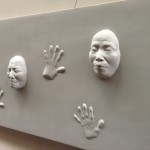 The women’s museum includes incredibly realistic animation of the experiences of the sex slaves at Japanese military bases scattered around the Pacific (the victims also included women from the Philippines and Holland). It was tremendously inspiring to see the photos and testimony of the brave Korean women who came forward to tell the stories of the comfort women in the 1980s, when the veil was first lifted on this terrible story of human trafficking.
The women’s museum includes incredibly realistic animation of the experiences of the sex slaves at Japanese military bases scattered around the Pacific (the victims also included women from the Philippines and Holland). It was tremendously inspiring to see the photos and testimony of the brave Korean women who came forward to tell the stories of the comfort women in the 1980s, when the veil was first lifted on this terrible story of human trafficking.
It’s unbelievable and shocking that the Japanese governmentcontinues to deny these crimes, and that prominent politicians there downplay and even ridicule the accounts of those who suffered. (click here for an excellent historical analysis of these museums).
AFTER THE WAR, A “SMOULDERING RUIN”
Before describing the details of my visit and the reasons so many of us believe a peace treaty is critical to peace in Korea, it’s important to remember the horror of the Korean War. I lived in South Korea from 1959 to 1961, when my father was working for a church relief organization, and I have strong memories of its impact on the south – hills denuded of trees, thousands of widows and orphans, vivid stories of families fleeing the fighting and split by the division, a polarized and repressed society. Here’s what David Carter, a British journalist and historian in Korea, wrote about the war in 2010 in Contemporary Review: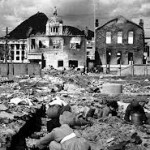
[The Korean War] was a total disaster for the entire Korean peninsula. The historian Bruce Cumings has described the effects in shocking and gruesome detail: the entire country was a “smouldering ruin,” hardly a building was left standing anywhere, and the capital, Seoul, presented a nightmarish landscape with hollow shells of buildings as far as the eye could see…Cities everywhere, including also the northern capital of Pyongyang, were piles of rubble and ashes.
People were living in tunnels, caves and makeshift shacks: they had to start rebuilding their lives using only the refuse of war. In the War Memorial Museum in Seoul you can walk between life-size dioramas of cityscapes wasted by the war, which make it difficult to re-enter the normal world outside with an easy conscience. About a tenth, three million, of the entire population of Korea at the outbreak of the war, had been wounded, killed, or were missing; ten million Koreans were wandering around disorientated, separated from other members of their families.Virtually all industry, North and South, had been destroyed, dams had been blasted and the already devastated landscape inundated.
The gruesome toll of the dead includes three million Koreans, 186,000 Chinese and 38,000 Americans (as I report in The Nation this week, President Obama had the audacity and arrogance to call the war a “victory,” reviving a right-wing trope that has long been discredited by historians).
And in their generally terrible reporting on North Korea, U.S. journalists rarely mention the incredible destruction wrought on the North by the U.S. terror bombing campaign – click here and here for two well-documented accounts of these actions, which left North Korea, quite literally, in cinders.
THE PEACE SYMPOSIUM
Today, of course, Korea remains bitterly divided, and the clouds of war are still present. North Korea, which is committed to a military-first policy known as “song-gun,” has built and tested several nuclear weapons, and the U.S. and South Korea regularly hold massive military exercises where they practice nuclear strikes on the North and even stage mock run-throughs of regime change. As I wrote in Salon during the most recent “North Korea Crisis” in April, the Obama administration’s refusal to negotiate with North Korea at any level has exacerbated the situation. At the symposium, the dire situation was summarized by Jung-Hee Lee, a lawyer and feminist activist and chairperson of the UPP who ran for president in 2012:
Sixty years have passed since the armistice agreement was signed by Korea is still at war. The two military drills, so called Foal Eagle and Key Resolve, that were carried out in the spring of this year pushed the Korean peninsula into a serious nuclear crisis. A large number of nuclear weapons such as the U.S. nuclear-capable B-52 and B-2, and nuclear aircraft carrier Nimitz were deployed on and around the Korean Peninsula. North Korea forward-deployed its missiles as well. As such, the potential for military confrontation has reached its climax. We could learn from these experiences that peace cannot be attained in an unstable environment under the armistice agreement. We need to declare an end to the war and conclude a peace treaty on the Korean Peninsula immediately. Our challenge is to create a stable peace system now.
One of the best things about the conference was the participation by a large group of Japanese peace activists. They were there in part to protest the role of the Japanese government, the most conservative since World War II, in the ongoing tensions in Korea and particularly in the U.S. military buildup in Asia.
Hottori Ryoichi, who was until last year a member of the Japanese House of Representatives from Osaka, offered a withering critique of Japanese policy. He started out by reminding the audience what the Korean War meant to Japan – primarily that it was “not possible without the Japanese military bases” controlled by the United States, and that Japanese sales of vehicles and munitions to U.S. forces in Korea helped revive the postwar Japanese economy. “That ‘special demand’ from the Korean War was only made
possible by the Korean peoples’ blood,” he said. Hattori denounced Shinzo Abe’s new LDP government. In Japan, which is desperately seeking to change Japan’s peace constitution so it can participate in America’s global wars (and, not suprisingly, join the lucrative export of weapons).
“The Abe government is not even conservative; it’s an ultra-rightwing regime,” he said. “Overturning Abe would directly contribute to peace. His followers want to revive the Emperor’s Army.” He added that “to abandon the peace constitution would be unforgiveable to people around the world.” (Later, Byung-Ryul Min, a member of the UPP’s supreme council, declared that “the logic of Japan in 1941 was not that different from today’s ruling conservatives.”)
“A new era of the Cold War has come upon us,” added Watanabe Kenji, the chairperson of the Japan-Korea Peoples’ Solidarity National Network and a historian on Japanese militarism. He described how Japan is trying to “revise and distort history” with false accounts of the comfort women and by claiming “ownership” of islands claimed by Korea and China. He slammed recent joint military exercises held by the U.S. and South Korea as “provocations themselves,” and noted that the 1953 armistice agreement stipulated that, within three months, all foreign forces were supposed to be withdrawn. “The Korean War must end to achieve a permanent peace in Korean and Northeast Asia,” he concluded. “We now have a vicious cycle were no one trusts the other parties. We must give North Korea assurances against military provocations.” Other Japanese speakers linked the struggle against militarism to the ongoing battles to remove U.S. forces from Okinawa and stop South Korea from constructing a naval base in the southern island of Jeju (a movement recently joined by movie director Oliver Stone).
KOREANS REMEMBER THE “SUNSHINE POLICIES” OF KIM DAE JUNG
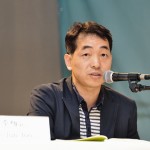 The strongest arguments for end to the war came from the Koreans themselves. Je Jun Joo of the Korean Alliance and a key figure in the movement against the Korea-U.S. Trade Agreement, summed up the costs of the war build-up to the Korean economy.
The strongest arguments for end to the war came from the Koreans themselves. Je Jun Joo of the Korean Alliance and a key figure in the movement against the Korea-U.S. Trade Agreement, summed up the costs of the war build-up to the Korean economy.
The defense budget of South Korea this year is about 35 trillion won (about $35 billion), which is about 15 percent of the whole countrys’ budget for a year…If the salaries of South Korea’s 600,000 soldiers were included in the budget, defense spending would easily place South Korea in the top five of the world. What we should also know is the fact that the ratio of importing foreign weapons is dramatically getting higher. In 2011, it exceeded one-third of the defense budget and was close to 30 percent of the arms exported by the United States. It is so clear who makes profits from the situation on the Korean peninsula.
Joo also offered a sobering overview of the military exercises that North Korea claims its nuclear deterrence is aimed at.
These exercises, also known as “Team Spirit,” “Ulchi Focus Lens,” “Key Resolve,” and “Ulchi Freedom Guardian,” have taken place for decades to practice attacking North Korea. And about 50,000 to 200,000 forces are currently mobilized for these exercises. On top of this, South Korea and the United States have established operational plans including “destroying the North Korean structure,” “North Korea leader assassination operations,” and “preemptive attack against North Korea’s major facilities,” OPLAN 5027 (Total War), OPLAN 50230 (psychological warfare against North Korea). As you can see, it same hard to realize such ideas as “mutual equality,” “realizing peace,” or “solving the problem by having conversations,” in this peninsula.
That, of course, is a direct shot at the Obama administration, which defends its Asia policies, including its massive shift of military resources to the Pacific, as a giant peace-keeping operation. Koreans at the conference and in general are already fed up with
Obama’s hardline policies towards the North and his warm embrace of South Korea’s conservative presidents, including the current leader, Park Geun-hye, the daughter of the former dictator Park Chung Hee, and Lee Myung Bak, the right-wing Hyundai executive who preceded her and under whose reign tensions with the North rose to record levels (to their disgust, Obama, who got along famously with Lee, once called him “his favorite president.”)
In their minds, one of the most important steps to peace would be the dismantling of the U.S.-Korean Joint Command, led by a U.S. general. As I said in my speech to the conference, South Korea is the only country in the world in which a foreign general is in command of its army at times of war. The UPP and much of the popular movement also want to see the withdrawal of the 28,000 U.S. troops stationed in South Korea. “Voters here have to make that decision to drive U.S. forces out of Korea,” said Park, the institute’s vice president. During the demonstration at Yongsan, the crowds chanted for U.S. troops to get out. Such open displays of antipathy towards the American military would have been unheard of during South Korea’s dictatorial past, which lasted from 1945 to 1988.
Another demand is a return to the more conciliatory policies that dominated during the presidencies of Kim Dae Jung and Roh Moo Hyun, roughly from 1998 to 2006. During that time, extensive agreements were made with North Korea (then led by the first hereditary dictator, Kim Jong Ill) on cultural, sports, education and political exchanges. Major projects included a railway linking North and South (it was even blessed by George Bush in a 2003 visit), and a joint industrial zoneestablished in Kaesong, just north of the DMZ (the same one that North Korea shut down in April and has been the subject of recent negotiations between Seoul and Pyongyang).
I heard stories of the fruits of this rapprochement from my friends, including a specialist in nano-technology who was involved in joint seminars organized by top North and South Korean universities. One UPP activist told me how, on one trip, he was even allowed to drive his own car through the checkpoints at the DMZ all the way to Pyongyang. Looking at the border today, that seemed like a faraway dream. Min of the UPP, which has extensive political ties in Japan and China, laid out in detail some of the political exchanges that took place during the “Sunshine policy” years. His contact in North Korea, he said, was not Kim Jong Il’s ruling (in the absolute sense) communist party, but the North Korean Social Democratic Party.
The UPP, he said, had working group-level talks with the North Korean Social Democrats in 2004, then “made an official visit to Pyongyang and had an official meeting among delegations from both sides between August 22 to 27, 2005. The second bipartisan talks were held between November 15 to 19, 2008. The working group contacts were in progress until 2009. Unfortunately, the current inter-Korean relation is at an impasse and is blocking further inter-party exchanges.” As one friend of mine put it, “when Lee Myung Bak came into office, everything stopped.”
As Gregory Elich pointed out, South Korea’s rightward turn is a blessing for the Pentagon and the U.S. national security elite. “South Korea’s geostrategic importance to the U.S. means that if the expression of popular will is strong enough, it may be difficult to ignore,” he said. “In the years ahead, if a more progressive government comes to power in South Korea, the United States may not be able to exclude a peace treaty from a denuclearization settlement, nor indeed to say no to engagement in the first place.”
US ELITES VS THE KOREAN PEOPLE
Elich quoted from a disgusting report published by the Center for a New American Security, the corporate/contractor-funded think-tank of Washington’s global counterinsurgency warriors. 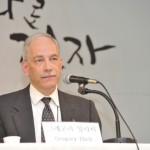 It complained bitterly about the South Korean left and its ability to mobilize thousands of people in the movement against the U.S.-South Korean military alliance. A key “challenge for the [military] alliance,” the paper states, “relates to managing populist fervor in Korea.” (coming from Bush and Obama foreign policy hacks Victor Cha and Kurt Campbell, that’s not surprising; but the report is truly astonishing in its triumphalism and complete arrogance towards the Korean people – read it here).
It complained bitterly about the South Korean left and its ability to mobilize thousands of people in the movement against the U.S.-South Korean military alliance. A key “challenge for the [military] alliance,” the paper states, “relates to managing populist fervor in Korea.” (coming from Bush and Obama foreign policy hacks Victor Cha and Kurt Campbell, that’s not surprising; but the report is truly astonishing in its triumphalism and complete arrogance towards the Korean people – read it here).
My take on Korea and its relationship with the United States is very much along the lines expressed at the symposium. In my speech, I was extremely critical of Obama’s policies, but also focused on the failure of the U.S. press to report either objectively or accurately about Korea, North and South. But I reserved much of my critique to the U.S. left – of which I am a part. It seems to me that after the Vietnam War, which the left fiercely opposed, American progressives basically forgot about Asia. Worse, progressives have, with rare exceptions (Oliver Stone, Code Pink), treated the South Korean movement for democracy with disdain and even contempt. Here’s part of what I said:
Unfortunately, many Americans who should be our allies in building peace in Korea have adopted Cold War thinking as well. This is especially true of the press, which – as I’ve said – always portrays North Korea as the evil instigator and rarely mentions how U.S. policies, including threats to use nuclear weapons against the DPRK, have contributed to the tensions. But it’s also true of progressives as well.
Many of you fought against the Korea-U.S. Free Trade Agreement known as KORUS. You correctly saw KORUS as a treaty that will make it easier for capital to move across borders and hurt the interests of workers, unions, farmers and consumers. This view is shared by many U.S. trade unionists as well. But the organization that led the fight against KORUS and is in the forefront of the fight against TPP seized on only one issue: the Kaesong Free Trade Zone (that, ironically, is about to reopen).
In its literature and campaigns, this U.S. organization argued that Kaesong is a “slave labor” camp that will finance North Korea’s acquisition of nuclear weapons, and therefore its inclusion in KORUS had to be opposed. This Cold War, simplistic view put this organization and many U.S. trade unions to the right of the most extreme elements of the Republican Party and far to the right even of the Korean conservative presidents Lee and Park. Worse, it completely denies South Korea’s sovereign right to reduce tensions and build economic ties with North Korea on its own terms. With “friends” like this, you do not need enemies.
I would encourage progressive Americans to heed my words and find out for yourselves what South Koreans have to say about North Korea, their hopes for a more democratic society, and the U.S. role in their country. We should assist our counterparts in South Korea pressure the Obama administration to change its policies away from war and towards peace. As a singer at one of the protests sang – inspiring my own quotations from John Lennon – “Imagine.” Imagine a less militaristic America. Imagine a North Korea without nukes and a South Korea without foreign troops on its soil (yes, we’re the only ones). Imagine a peaceful Korea. Imagine an eventually united Korea. It could be done.
By Tim Shorrock, timshorrock.com

